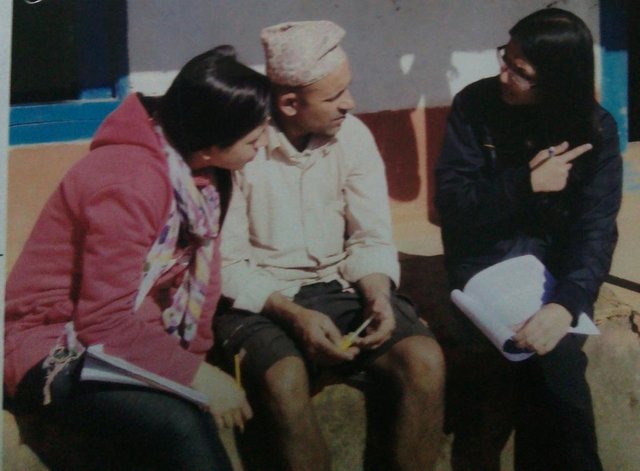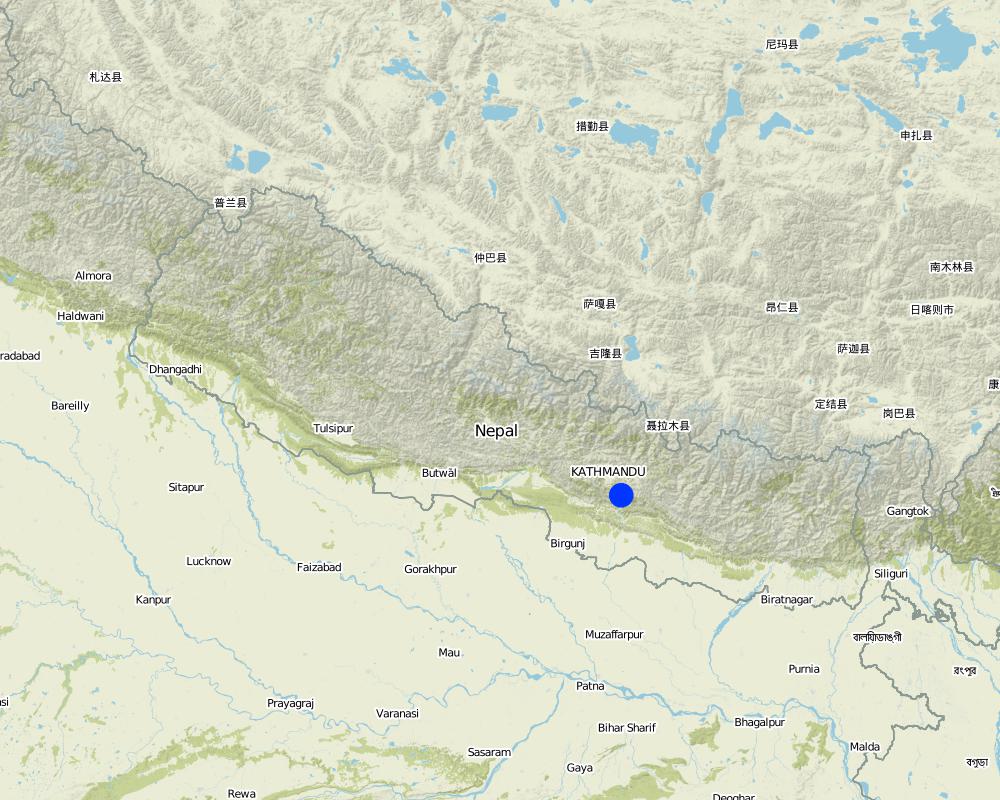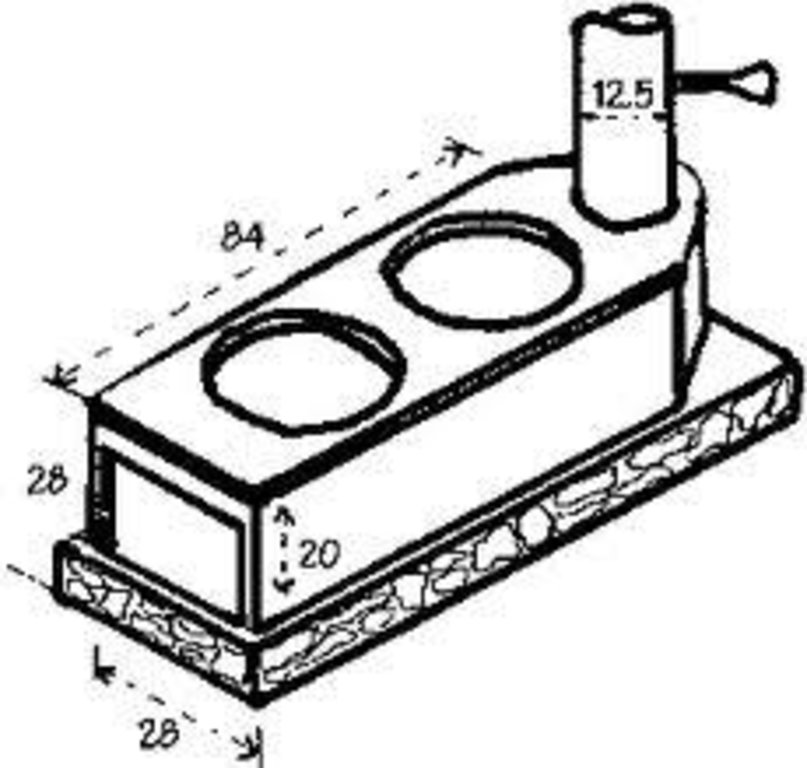Improved Stove for household cooking use [Népal]
- Création :
- Mise à jour :
- Compilateur : Sabita Aryal
- Rédacteur : –
- Examinateurs : David Streiff, Alexandra Gavilano
Sudhariyeko chulo
technologies_1202 - Népal
Voir les sections
Développer tout Réduire tout1. Informations générales
1.2 Coordonnées des personnes-ressources et des institutions impliquées dans l'évaluation et la documentation de la Technologie
Spécialiste GDT:
Shrestha Ishani
Kathmandu University
Népal
Spécialiste GDT:
Manandhar Shishir
Kathmandu University
Népal
Nom du ou des institutions qui ont facilité la documentation/ l'évaluation de la Technologie (si pertinent)
Kathmandu University (KU) - Népal1.3 Conditions relatives à l'utilisation par WOCAT des données documentées
Le compilateur et la(les) personne(s) ressource(s) acceptent les conditions relatives à l'utilisation par WOCAT des données documentées:
Oui
1.4 Déclaration sur la durabilité de la Technologie décrite
Est-ce que la Technologie décrite ici pose problème par rapport à la dégradation des terres, de telle sorte qu'elle ne peut pas être déclarée comme étant une technologie de gestion durable des terres?
Non
1.5 Référence au(x) Questionnaires sur les Approches de GDT (documentées au moyen de WOCAT)

Chyamrangbesi - A smoke free zone by using … [Népal]
The ways and means used to promote and implement to improved stove to improve human well-being and sustainable land use.
- Compilateur : Sabita Aryal
2. Description de la Technologie de GDT
2.1 Courte description de la Technologie
Définition de la Technologie:
The technoloigy is engineered in such a way that there will be less consumption of wood and less emission of smoke.
2.2 Description détaillée de la Technologie
Description:
The technology document is entitled"improved Stove In Rural Areas".This technology brings more effective way of cooking compared to the old one.Here,unlike the rural areas wood consumption is lesser and wood consumption is lesser and there is also proper outlet of smoke produced.In the old stove more wood and fuelwood were consumed and smoke were accumul;ated in the cooking site which is the kitchen.Thus it reduces health hazards.
Here we have a single input area to enter the fuelwood for a pair os stoves. This is done because the heat pressure is not allowed to escape and the same heat produced shifts in the other stove and helps in heating.
Purpose of the Technology: The purpose cof the technology was to reduce the health hazards due to accumulation of smoke in the kitchen to reduce the fuelwood consumption, to save time in cooking and hence to maintain a smoke free zone.
Establishment / maintenance activities and inputs: The plant was first initiated by VDC in magh(2068B.S) by the assistance of Remerick Chyamrangbesi VDC and other co operatives.The first step was that labourers and technicians were given training an how to set up the stoves.Then they were assigned to construct it in homes.The labour charge and wages were covered by the organisation.The skills were not hightech so the skill was passed to the individuals of house and the maintenance was done.
Also, the organization send a person per year to if the stove is in proper working condition or not.
Natural / human environment: The technology mainly focuses on the health of the people exposed due to the indoor pollution.Since there was proper outlet no smoke was trapped inside which massively reduced air pollution.Besides less firewood was consumed,hence reducing the rate of deforestation and smoke emission.Also the ashes obtained from the burning firewood was a good fertilizer.
2.5 Pays/ région/ lieux où la Technologie a été appliquée et qui sont couverts par cette évaluation
Pays:
Népal
Région/ Etat/ Province:
Chyanrangbesi
Autres spécifications du lieu:
Kavrepalanchowk
Spécifiez la diffusion de la Technologie:
- appliquée en des points spécifiques ou concentrée sur une petite surface
Commentaires:
The village Chyangbesi has an area of 28.97 sq km. (source VDC database)
Map
×2.6 Date de mise en œuvre de la Technologie
Si l'année précise est inconnue, indiquez la date approximative: :
- il y a moins de 10 ans (récemment)
2.7 Introduction de la Technologie
Spécifiez comment la Technologie a été introduite: :
- par le biais de projets/ d'interventions extérieures
Commentaires (type de projet, etc.) :
Feb 2012: initiation by 24th Jestha
3. Classification de la Technologie de GDT
3.1 Principal(aux) objectif(s) de la Technologie
- créer un impact social positif
3.2 Type(s) actuel(s) d'utilisation des terres, là où la Technologie est appliquée

Implantations, infrastructures
- Energie: pipelines, lignes haute tension
Commentaires:
Major land use problems (compiler’s opinion): Irrigation facilities were not monitored.
3.5 Groupe de GDT auquel appartient la Technologie
- technologies d'efficacité énergétique
3.6 Mesures de GDT constituant la Technologie

autres mesures
3.7 Principaux types de dégradation des terres traités par la Technologie

dégradation biologique
- Bq: baisse de la quantité/ biomasse
Commentaires:
Main causes of degradation: deforestation / removal of natural vegetation (incl. forest fires) (Deforestation for fuelwood)
3.8 Prévention, réduction de la dégradation ou réhabilitation des terres dégradées
Spécifiez l'objectif de la Technologie au regard de la dégradation des terres:
- prévenir la dégradation des terres
- réduire la dégradation des terres
4. Spécifications techniques, activités, intrants et coûts de mise en œuvre
4.1 Dessin technique de la Technologie
Spécifications techniques (associées au dessin technique):
Two stoves are attached and firewood you require for first stove with input only.Heat is transferred to another stove aswell.It works on the principle of heat entrapment.
Location: Chyamrangbesi. Kavre
Date: 3/12/2012
Technical knowledge required for field staff / advisors: low (field staffs taught the technique to local people)
Main technical functions: increase in nutrient availability (supply, recycling,…)
Secondary technical functions: increase in organic matter, promotion of vegetation species and varieties (quality, eg palatable fodder), reduction of dry material (fuel for wildfires)
Structural measure: Soil shape
Vertical interval between structures (m): S,C,E
Structural measure: Iron,Chimney
Vertical interval between structures (m): O
Construction material (earth): soil excavated
Construction material (concrete): Concretes were used to make the structure solid and stable.
Construction material (other): Iron and tin was used to make the chimney and also to suppoirt the structure.
Auteur:
Shishir Manandhar, Gauridhara.Kathmandu
4.3 Activités de mise en place/ d'établissement
| Activité | Calendrier des activités (saisonnier) | |
|---|---|---|
| 1. | Technicians were trained by Rimrek | MAgh 2068 |
| 2. | Construction | magh 2068 |
| 3. | Final | Jestha 24,2069 |
| 4. | Materials cost |
4.4 Coûts et intrants nécessaires à la mise en place
| Spécifiez les intrants | Unité | Quantité | Coûts par unité | Coût total par intrant | % des coût supporté par les exploitants des terres | |
|---|---|---|---|---|---|---|
| Main d'œuvre | Labour | unit | 1,0 | 400,0 | 400,0 | |
| Coût total de mise en place de la Technologie | 400,0 | |||||
| Coût total de mise en place de la Technologie en dollars américains (USD) | 400,0 | |||||
4.5 Activités d'entretien/ récurrentes
| Activité | Calendrier/ fréquence | |
|---|---|---|
| 1. | Monitoring |
4.6 Coûts et intrants nécessaires aux activités d'entretien/ récurrentes (par an)
Commentaires:
Machinery/ tools: Hand hoe
Labours as raw materials and ingrediaments were locally available, and hence free.Thus expenses was mainly on labour charge.Mininmum quantity of iron were used but so it was negligible.
4.7 Facteurs les plus importants affectant les coûts
Décrivez les facteurs les plus importants affectant les coûts :
Labour Skills: Initially the skilled people were hired to construct the stove and then the skills were acquired by the villagers so thet they can themselve make it onwards.The raw materials required were locally available which reduced the cost.
5. Environnement naturel et humain
5.6 Caractéristiques des exploitants des terres appliquant la Technologie
Revenus hors exploitation:
- 10-50% de tous les revenus
Niveau relatif de richesse:
- pauvre
- moyen
Individus ou groupes:
- groupe/ communauté
Genre:
- femmes
- hommes
Indiquez toute autre caractéristique pertinente des exploitants des terres:
Land users applying the Technology are mainly common / average land users
5% of the land users are rich and own 20% of the land.
85% of the land users are average wealthy and own 70% of the land.
10% of the land users are poor and own 10% of the land.
Off-farm income specification: There wasn't any significant charge in the economy but pollution was kept in check and reduce future expenses in terms of medical expenditure.
5.7 Superficie moyenne des terres utilisées par les exploitants des terres appliquant la Technologie
- < 0,5 ha
- 0,5-1 ha
- 1-2 ha
- 2-5 ha
- 5-15 ha
- 15-50 ha
- 50-100 ha
- 100-500 ha
- 500-1 000 ha
- 1 000-10 000 ha
- > 10 000 ha
Cette superficie est-elle considérée comme de petite, moyenne ou grande dimension (en se référant au contexte local)?
- petite dimension
5.8 Propriété foncière, droits d’utilisation des terres et de l'eau
Propriété foncière:
- communauté/ village
Droits d’utilisation des terres:
- communautaire (organisé)
Droits d’utilisation de l’eau:
- communautaire (organisé)
Commentaires:
Every household had their own land property. But common areas and forests were used for utilization of fuel.
5.9 Accès aux services et aux infrastructures
santé:
- pauvre
- modéré
- bonne
éducation:
- pauvre
- modéré
- bonne
assistance technique:
- pauvre
- modéré
- bonne
emploi (par ex. hors exploitation):
- pauvre
- modéré
- bonne
marchés:
- pauvre
- modéré
- bonne
énergie:
- pauvre
- modéré
- bonne
routes et transports:
- pauvre
- modéré
- bonne
eau potable et assainissement:
- pauvre
- modéré
- bonne
services financiers:
- pauvre
- modéré
- bonne
6. Impacts et conclusions
6.1 Impacts sur site que la Technologie a montrés
Impacts socio-économiques
Production
production agricole
Commentaires/ spécifiez:
Ash was used as fertiliser
Revenus et coûts
charge de travail
Commentaires/ spécifiez:
Less firewood consumption
Impacts socioculturels
situation sanitaire
Quantité avant la GDT:
N/A
Quantité après la GDT:
N/A
Commentaires/ spécifiez:
Reduce indoor pollution
livelihood and human well-being
Commentaires/ spécifiez:
Specifically,the health hazards due to indoor air pollution and smoke effects has massively reduced.
Impacts écologiques
Réduction des risques de catastrophe et des risques climatiques
émissions de carbone et de gaz à effet de serre
Quantité avant la GDT:
N/A
Quantité après la GDT:
N/A
Commentaires/ spécifiez:
Less firewood conmsumption so less smoke produced
6.2 Impacts hors site que la Technologie a montrés
Emission of smoke
Commentaires/ spécifiez:
Less smoke generated
Health hazards
Commentaires/ spécifiez:
Systematic arrangement of smoke,less smoke,proper outlet of smoke
6.3 Exposition et sensibilité de la Technologie aux changements progressifs et aux évènements extrêmes/catastrophes liés au climat (telles que perçues par les exploitants des terres)
Commentaires:
Since the technology was indoor none of the above factors had only effect on technology,
6.4 Analyse coûts-bénéfices
Quels sont les bénéfices comparativement aux coûts de mise en place (du point de vue des exploitants des terres)?
Rentabilité à court terme:
légèrement positive
Rentabilité à long terme:
positive
Quels sont les bénéfices comparativement aux coûts d'entretien récurrents (du point de vue des exploitants des terres)?
Rentabilité à court terme:
neutre / équilibrée
Rentabilité à long terme:
neutre / équilibrée
Commentaires:
Funds were given by VDC for establishment. The locals acquired the skills later and maintainence cost effective.
6.5 Adoption de la Technologie
De tous ceux qui ont adopté la Technologie, combien d'entre eux l'ont fait spontanément, à savoir sans recevoir aucune incitation matérielle, ou aucune rémunération? :
- 0-10%
Commentaires:
100% of land user families have adopted the Technology with external material support. Remerick and Chyamrangbesi VDC supplied full financial assistance. VDC and Remerick brought the technique and trained the technicians paying their wages. There is a strong trend towards spontaneous adoption of the Technology. Since it is hygenic and pollution free and also there is less consumption of fuel it is growing fast.
6.7 Points forts/ avantages/ possibilités de la Technologie
| Points forts/ avantages/ possibilités du point de vue de l'exploitant des terres |
|---|
| Health problems resulting from smoke have been less of a problem |
| Time period for cooking was comparatively lesser. |
| Points forts/ avantages/ possibilités du point de vue du compilateur ou d'une autre personne ressource clé |
|---|
| Less firewood was consumed leading to minimum indoor pollution |
| Saved time in wood collection as less firewood was consumed |
6.8 Faiblesses/ inconvénients/ risques de la Technologie et moyens de les surmonter
| Faiblesses/ inconvénients/ risques du point de vue de l’exploitant des terres | Comment peuvent-ils être surmontés? |
|---|---|
| No disadvantages |
| Faiblesses/ inconvénients/ risques du point de vue du compilateur ou d'une autre personne ressource clé | Comment peuvent-ils être surmontés? |
|---|---|
| Though lesser smoke is produced smoke is still harmful to atmosphere | Filtering devices can be inserted in chimneys,but that will be expensive. |
| Instead of blowing air by mouth certain mechanical devices can be use | Devices available in market can be used |
7. Références et liens
7.1 Méthodes/ sources d'information
- visites de terrain, enquêtes sur le terrain
- interviews/entretiens avec les exploitants des terres
7.2 Références des publications disponibles
Titre, auteur, année, ISBN:
www.mapkarta.com
Disponible à partir d'où? Coût?
Thamel
Liens et modules
Développer tout Réduire toutLiens

Chyamrangbesi - A smoke free zone by using … [Népal]
The ways and means used to promote and implement to improved stove to improve human well-being and sustainable land use.
- Compilateur : Sabita Aryal
Modules
Aucun module trouvé



